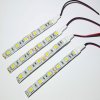Dear Sir,
I am hoping you can help me with a circuit, not being a professional and only an amateur.
I have a 00 gauge model train layout. On it is a lighthouse that I have attached a couple of LED strips.
I have a few 555 timers and carriers and was wondering what it would take to make a slow flash, similar to what a lighthouse
would be. The strips, as can be seen via the photograph enclosed, do contain components to allow to work via
directional 12 DC or DCC omnidirectional voltage. Hope to get a reply. Anything appreciated.
Best Wishes,
Lee
I am hoping you can help me with a circuit, not being a professional and only an amateur.
I have a 00 gauge model train layout. On it is a lighthouse that I have attached a couple of LED strips.
I have a few 555 timers and carriers and was wondering what it would take to make a slow flash, similar to what a lighthouse
would be. The strips, as can be seen via the photograph enclosed, do contain components to allow to work via
directional 12 DC or DCC omnidirectional voltage. Hope to get a reply. Anything appreciated.
Best Wishes,
Lee

